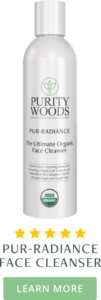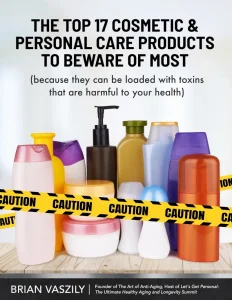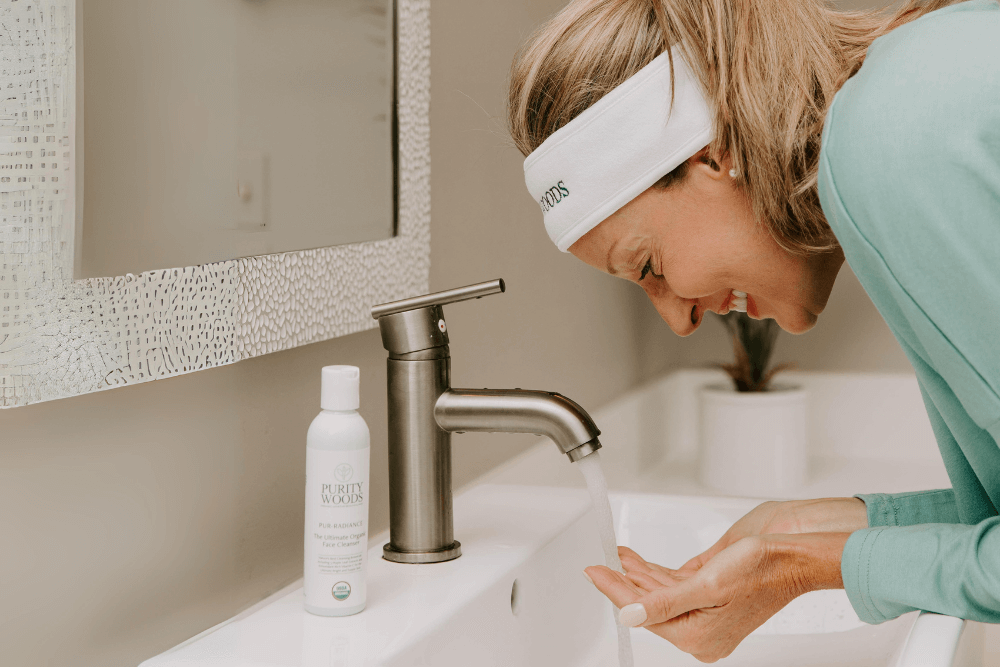Are you truly giving your skin the care it deserves? While washing your face may seem simple enough, many people aren’t doing it properly—or worse, aren’t doing it at all!
According to a survey of 1,000 adults, a staggering 60%, don’t feel knowledgeable about the right way to cleanse their faces. Even more concerning, 54% admit to not washing their faces before bed. Plus, 55% of people with dry skin and a third of those with oily skin say they only wash their face with water, not a cleanser.
How you cleanse your face is critical–not only for your appearance but your health.
Your skin is your body’s largest organ and your facial skin is thinner and more fragile. Plus, it’s incredibly porous, “drinking in” whatever you apply to it–including the synthetic and toxic chemicals lurking in many cleansers, even ones that call themselves “natural.”
The good news is nature has provided us with gentle yet powerful cleansing ingredients that not only wash away impurities but nourish and protect our skin. For example, three maple leaf extracts are scientifically proven to help preserve elastin, the protein responsible for maintaining skin elasticity and youthfulness. Some even refer to these extracts as the “fountain of youth.”
You just need to know what to look for in a cleanser and how to ensure your skincare routine sets you up for success. Here are the top “do’s and don’ts” for cleansing your skin.
DON’T Go to Bed Without Washing Your Face
While it might be tempting to crawl into bed after a long day without washing your face, don’t do it! The skin on your face contains more oil glands than any other part of your body. This is particularly true of the “T-zone,” which includes your forehead, nose, and chin. Neglecting to cleanse can result in clogged pores, breakouts, and dull skin.
You also don’t want to go to bed without removing your makeup. While you sleep, your skin goes into repair mode, shedding dead cells and renewing itself. Makeup forms a barrier that stops this natural process from happening. Plus, makeup traps in oil and bacteria, increasing the likelihood of breakouts. So, before you cozy up under the covers, take a few minutes to cleanse your face.
DON’T Wash Your Face with Just Water
While it might be tempting to splash your face with water and call it good, makeup and other skincare products typically aren’t water soluble. Instead, you need to use a cleanser that reduces the surface tension on your skin, removing not only makeup but also creams, dirt, and your skin’s natural excess oils.
DON’T Use Products that Contain Fragrance, Parabens or Sulfates
Look closely at the ingredients on many soap and cleanser labels and you’re likely to see fragrance, parabens, and sulfates, which are three ingredients you never want to put on your skin!
Let’s start with “fragrance,” which may also be called “parfum” or “scent” on the ingredient label. Companies aren’t required to disclose which chemicals are in “fragrance” because that’s a trade secret. Yet, unfortunately, it could be any one of the more than 3,000 chemicals in the U.S., including ones known to be carcinogens, neurotoxins, allergens, or other potentially toxic ingredients.
You also want to watch out for any ingredient ending in “paraben,” such as methylparaben, propylparaben, and butylparaben. These are often added to prevent bacterial and mold growth, but they’re also xenoestrogens, which mimic estrogen in the body. Research has found parabens are readily absorbed and tend to accumulate in the body’s tissues and fluids.
Finally, you want to inspect the label for sulfates, like Sodium Lauryl Sulfate and Sodium Laureth Sulfate. Manufacturers add them to produce lathers and bubbles in soap. Yet they can also strip your skin of its natural oils, enhance skin surface penetration, and are associated with skin, eye, and lung irritations, as well as allergic reactions.
DON’T Use Too Much Pressure
One of the most common mistakes people make when washing their face is using too much pressure. Vigorously scrubbing the skin can cause micro-tears and damage the skin’s natural barrier, leading to irritation and inflammation. Instead, gently massage the cleanser onto your skin using gentle circular motions, especially around the delicate eye area.
DO Look for a Cleanser That Contains Maple Leaf Extract
 In a groundbreaking study in 2018, researchers from the University of Rhode Island found that special compounds in red maple leaf extracts may have fountain-of-youth-like benefits for the way skin looks. Specifically, they found that there are compounds in maple leaves known as glucitol-core-containing gallotannins (GCGs), which block the activity of elastase, the enzyme that degrades elastin.
In a groundbreaking study in 2018, researchers from the University of Rhode Island found that special compounds in red maple leaf extracts may have fountain-of-youth-like benefits for the way skin looks. Specifically, they found that there are compounds in maple leaves known as glucitol-core-containing gallotannins (GCGs), which block the activity of elastase, the enzyme that degrades elastin.
This is important because the breakdown of elastin is what causes the telltale signs of aging: wrinkles, sagging, thinning, and the dreaded crepe-like texture. Maple leaf extracts can help reverse this process, leading to skin that looks firmer and younger. Plus, research has also found it can help fade age spots!
DO Exfoliate Your Skin 2 to 3 Times a Week
Exfoliating your skin two to three times a week with a natural exfoliator is an important part of maintaining healthy skin.
Gentle exfoliation helps improve blood flow to the skin, prevent the breakdown of collagen and elastin, and enhance the skin’s elasticity. Plus, by removing dead skin cells, makeup residue, and pollutants, exfoliation allows your other skincare products to penetrate the skin and work more effectively.
Do Make Sure Your Cleanser is USDA Certified Organic

Sadly, many products that promise to cleanse your skin contain dirty ingredients, which can cause early aging and worse. That’s why it’s important to choose a cleanser that doesn’t just say “natural” or “made with organic ingredients” on the label but one that has earned the USDA Certified Organic seal. This seal, independently granted, guarantees the product meets stringent guidelines.
To be USDA Certified Organic, a cleanser must contain zero synthetic or potentially harmful ingredients you don’t want to feed your skin and body. It also guarantees all ingredients were organically grown free from pesticides, herbicides, and other harmful chemicals. Plus, the product must be independently certified to contain 95% or more truly organic ingredients, with the remaining 5% strictly limited to safe substances that, by definition, can’t be organic, such as minerals.
Finally, a product can only put USDA Certified Organic on its label if every ingredient goes through a rigorous independent review–from where the plant-based organic ingredients are grown to the manufacturing facility where the cleanser is made. It’s the best way to gain peace of mind.
DO Rinse with Lukewarm Water
When washing your face, you want to make sure the water isn’t too hot or too cold. Hot water can disrupt your skin’s natural barrier, stripping it of oils and leaving it dry and irritated.
While less damaging than hot water, cold water will cause pores to close, trapping makeup and oils. Plus, cold water may not dissolve makeup and other debris as thoroughly as warm water.
Ideally, you want to cleanse with lukewarm water, which helps to open pores and allows for deeper cleansing and better absorption of skincare products. This is the same reason why aestheticians typically wrap your face in a warm moist towel before performing treatments.
DO Pat Your Skin Dry with a Clean Face Towel
While it might be tempting to reuse the same bath towel to dry your face, those towels can harbor bacteria, oils, and dirt—transferring them right back onto your skin. Plus, towels can accumulate dead skin cells over time, which can exacerbate skin issues. For these reasons, it’s best to use a clean towel that you only use on your face.
You also want to be gentle and avoid rubbing your skin with a towel, as this can cause friction and irritation—potentially creating microtears and damage to the skin’s natural barrier. Instead, gently press the towel against your skin to absorb excess water, leaving your skin slightly damp before applying moisturizer.
The All-In-One Cleanser that Checks All the Boxes

If you’re looking for a facial cleanser that not only deep cleans but nourishes and restores a youthful glow to your aging skin, look no further than the Pur-Radiance FaceCleanser from Purity Woods.
This unique formula contains a blend of 21 natural ingredients that work together to safely and effectively cleanse your skin. Plus, it contains three types of organic maple leaf extract, the holy grail ingredient proven to help protect elastin and combat fine links, wrinkles, and age spots.
With its USDA Certified Organic status, you can rest assured that it is free from harmful synthetic additives, making it safe for your skin’s health and overall well-being. What’s more, this face cleanser is non-comedogenic and designed to work wonders on all skin types, including dry and sensitive skin.
If you’re looking for a natural and refreshing cleansing experience that effectively revives your skin’s youthful glow, learn more about Pur-Radiance here! Invest in your skin’s health today – your glowing complexion can’t wait!



Ihave washed my face with a little soap and warm water for nearly 80 years and dried gently with a small towel used just for face and hands and people are surprised when I tell them how old I am. people use far too many chemicals and products in every aspect of their lives, the majority of which are dangerous for our lungs as well.